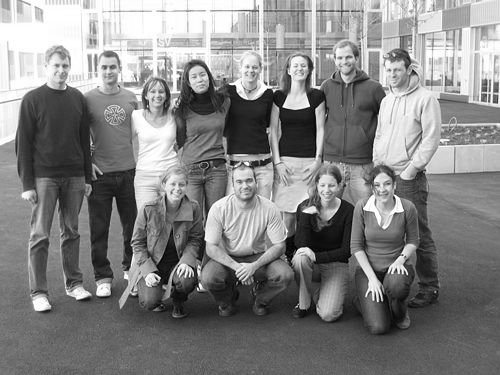Team:EPF-Lausanne/Project Abstract
From 2009.igem.org
| Line 17: | Line 17: | ||
<script> | <script> | ||
function haxbackground(){ | function haxbackground(){ | ||
| - | document.getElementById('cartoonmap').style.backgroundImage='url(https://static.igem.org/mediawiki/ | + | document.getElementById('cartoonmap').style.backgroundImage='url(https://static.igem.org/mediawiki/2009/e/e7/GroupNB.jpg)'; |
} | } | ||
function unhaxbackground(){ | function unhaxbackground(){ | ||
Revision as of 07:28, 2 September 2009
Contents |
- Maarten Breckpot
-
Maarten Breckpot
Studies:
1st Master of Applied Sciences and Engineering – Mathematical Engineering
Country:
Belgium - Nick Van Damme
-
Nick Van Damme
Studies:
1st Master of Applied Sciences and Engineering – Mathematical Engineering
Country:
Belgium - Benjamien Moeyaert
-
Benjamien Moeyaert
Studies:
3rd Bachelor of Biochemistry and Biotechnology
Country:
Belgium - Stefanie Roberfroid
-
Stefanie Roberfroid
Studies:
3rd Bachelor of Bioscience Engineering – Biomolecular Engineering
Country:
Belgium - Dries Vercruysse
-
Dries Vercruysse
Studies:
1st Master of Applied Sciences and Engineering - Nanoscience and Nanotechnology
Country:
Belgium - Andim Doldurucu
-
Andim Doldurucu
Studies:
1st Master of Bioscience Engineering – Nanoscience and Nanotechnology
Country:
Turkey - Hanne Tytgat
-
Hanne Tytgat
Studies:
3rd Bachelor of Biochemistry and Biotechnology
Country:
Belgium - Elke Van Assche
-
Elke Van Assche
Studies:
3rd Bachelor of Bioscience Engineering – Biomolecular Engineering
Country:
Belgium - Jan Mertens
-
Jan Mertens
Studies:
1st Master of Bioscience Engineering – Biomolecular Engineering
Country:
Belgium - Nathalie Busschaert
-
Nathalie Busschaert
Studies:
3rd Bachelor of Chemistry
Country:
Belgium - Jonas Demeulemeester
-
Jonas Demeulemeester
Studies:
1st Master of Biochemistry and Biotechnology
Country:
Belgium - Antoine Vandermeersch
-
Antoine Vandermeersch
Studies:
2nd and 3rd Bachelor of Applied Sciences and Engineering – Electrical and Materials Engineering
Country:
Belgium
What we want to do
Light-sensitive proteins can easily be found in nature, but they have never been cloned into other cells. In this project, our aim is to design a fusion protein that would allow genetic regulation through light control.
Therefore we are working on cloning strategies that would allow us to fuse a light-sensitive domain (LovTAP in our case) with a regulatory domain (like the Trp operon). The idea is to allow transmission of the conformational change induced by light (on the light-sensitive domain) to the DNA-binding domain. This transmitted conformational change would then result in an increase or decrease of the regulatory domain's affinity for the DNA promoter site.
The overal effect would thus be a genetic expression controlled by light! There would be many applications to such a "switch" : it could kill bacteria at a certain point, stop their growth, or make them express specific proteins...
To improve the change induced by light (which is generally very unstable), we also plan a modeling part where the aim is to find which residue we would have to mutate in order to have a stable protein after the switch.
The advantage of such a system is that we could apply the light on a system and then remove it (not like if we added some liquid on the cells).
Project Abstract
Recent discoveries of photoreceptors in many organisms gave us insights into a possible interest of using light responsive genetic tools in synthetic biology. The final goal of our project is to induce a change in gene expression, more specifically to turn a gene on or off, in a living organism in response to a light stimulus.
We will use light sensitive DNA binding proteins, or light sensitive proteins that activate DNA binding proteins to transduce a light input into a chosen output, for example reporter genes like GFP, RFP. The genetic circuits allowing us to measure the activity and responsiveness of light sensitive proteins are already designed, whereas the parts and biobricks required to engineer these circuits are still in formation.
If we demonstrate that the light-induced-gene switch tool works in vivo, it would show that easier and faster tools could be used in several fields of biology. It would induce more localized, more precise (time resolution) and drastically faster genetic changes than the current used tools, which will then allow research to evolve even better.
 "
"

